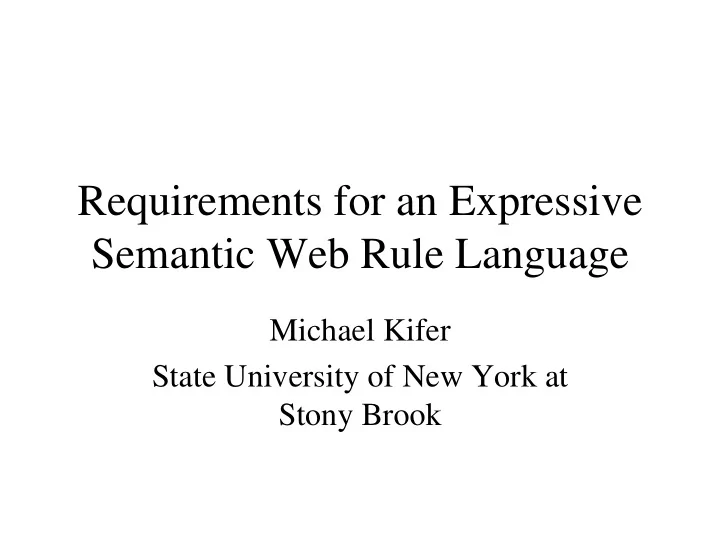

Requirements for an Expressive Semantic Web Rule Language Michael Kifer State University of New York at Stony Brook
The Role of a Rule Language: The RuleML, WSMO, SWSL View FOL++ Rules OWL RDF(S) XML Unicode URI
It’s The Features, Stupid! • Prolog was unsuccessful not because of performance, but because of features – Semantics Semantics: Not really declarative hence – – Features Features: Fairly feature-less and low-level –
What Is To Be Done • Fix the semantics • Add features • Web-ize
Fixing the Semantics • Pretty much done: systems like XSB use tabling to – Fix the incomplete Prolog’s search strategy – Implement the well-founded semantics for NAF (negation as failure) • And they run fast!
Adding Features • Not all features can be dropped into one language • But the ones to be discussed are orthogonal : can be combined and have been combined (for the most part) – E.g., FLORA-2 – Most of these are in SWSL-Rules
Feature Laundry List Approximate reasoning Logical paraconsistency Updates Constraints Declarative metaprogramming Constraint programming Frames Base: Datalog+NAF
Adding Frames • F-logic is a popular way to combine frames with rules (and, more generally, FOL) • Several implementations: – FLORA-2 – FLORID – Ontobroker (commercial) – TRIPLE (partial) • A basis for – WSMO-Rules – SWSL-Rules
Meta-Programming • Need second order syntax, but not semantics • One simple solution that goes a long way: HiLog (has been confirmed by its rediscovery in the form of SKIF) • Supports cleanly and tractably not only second- order syntax, but also reification
Logical Updates • Prolog’s assert/retract are not logical – hard to write programs correctly • A good solution is Transaction Logic : – Logical updates – Attached procedures – Triggers – Supports a variety of tasks, including planning
Approximate Reasoning • Annotated logic – Supports: • Paraconsistency • Easy to use • Naturally combines with rules – Problem: • Where are all the confidence factors coming from?
Constraints • Constraints and constraint logic programming are not new; most Prolog systems support them
Web-izing • URIs – a matter of syntax • Modules – Need labels to attach to logical theories, not just names of predicates/objects – An extensible integration mechanism with other theories (e.g., DL) and languages (procedural and rule-based) – Seems severely under-appreciated by the Web/Rules community • Only FLORA-2 and TRIPLE (and now WSML) got it right
Additional Niceties • Courteous rules – Prioritization – Classical negation • Lloyd-Topor – More natural expression of universal statements
Discussion
Recommend
More recommend